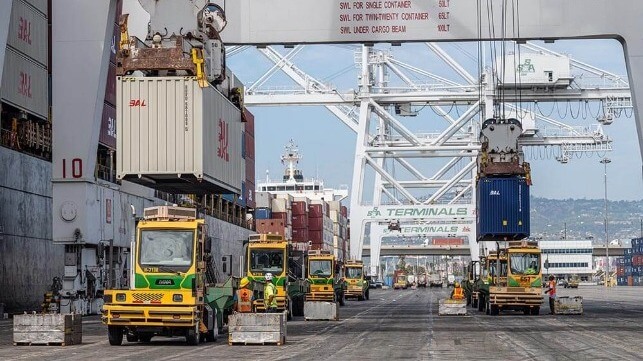U.S. Retail Imports Remained High Ahead of Tariffs but Maybe Slowing

While saying that it believes U.S. retailers continued to frontload imports of key products for several months ahead of a potential dockworkers strike and tariff increases, the National Retail Federation data now points to a slowing of month-to-month container volumes at the top U.S. ports. The trade association lowered its near-term forecast in the Global Port Tracker for U.S. container import volumes while saying it believes retailers continue to engage in diversification efforts to adjust supply chains.
“Unfortunately, it takes significant time to move supply chains, even if you can find available capacity,” said Jonathan Gold, Vice President for Supply Chain and Customs Policy at the NRF. “Retailers have engaged in mitigation strategies to minimize the potential impact of tariffs, including frontloading of some products, but that can lead to increased challenges because of added warehousing and related costs.”
The Global Port Tracker lowered its forecast for December 2024’s volume by 100,000 TEU at the major U.S. ports projecting the final number will be at 2.14 million TEU. While that would still be more than 14 percent ahead of 2023, it is down nearly one percent from November 2024. Further, the trade group lowered its January 2025 forecast by 50,000 TEU projecting the total at 2.11 million TEU. While that is up nearly eight percent over 2024, it would be another consecutive monthly decline. February 2025 is also projected to be down to 1.96 million TEU because of Lunar New Year factor shutdowns in China.
The NRF notes that the total for 2024 however rivaled the peak of 25.8 million TEU in 2021. It expects the final tally for 2024 at 25.5 million TEU which would be nearly 15 percent ahead of 2023. Strong consumer demand and low unemployment in the final months of the Biden administration contributed to continued strong retail sales and demand.
Port cargo “could be badly hit” if tariffs on overseas Asian and European nations increase prices and prompt consumers to buy less, said Ben Hackett, Founder of Hackett Associates. He notes that Trump’s now delayed tariffs on Canada and Mexico would initially have minimal impact at ports because most imports from either country move by truck, rail, or pipeline. In the long term, tariffs on goods that receive final manufacturing in Canada or Mexico but originate elsewhere could prompt an increase in direct maritime imports to the U.S. predicts Hackett.
The NRF is forecasting that container imports will begin to show month-over-month growth (as well as year-over-year) in the spring as retailers stock up for summer sales. March is forecast at 2.14 million TEU, up 11.1 percent year-over-year; April at 2.18 million TEU, up 8.2 percent; and May at 2.19 million TEU, up 5.4 percent. The current forecast however shows the increases could be short-lived with June container imports forecast at 2.13 million TEU, down 0.6 percent year-over-year and reversing the month-over-month gains.
Retailer imports are forecast at 12.71 million TEU for the first half of 2025. That would be a 3.6 percent increase over the first half of 2024.
